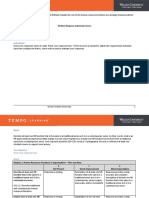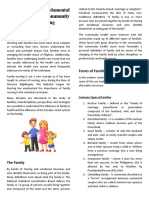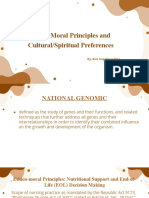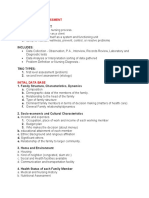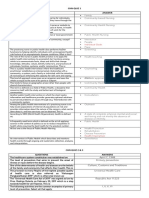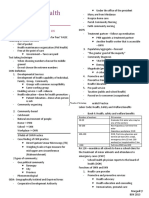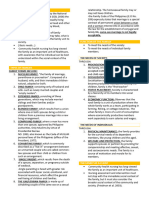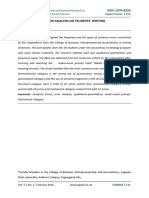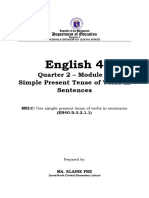Community Health Nursing
Community Health Nursing
Uploaded by
Iligan, JamaicahCopyright:
Available Formats
Community Health Nursing
Community Health Nursing
Uploaded by
Iligan, JamaicahOriginal Title
Copyright
Available Formats
Share this document
Read this document in other languages
Did you find this document useful?
Is this content inappropriate?
Copyright:
Available Formats
Community Health Nursing
Community Health Nursing
Uploaded by
Iligan, JamaicahCopyright:
Available Formats
COMMUNITY HEALTH NURSING 8.
FOSTER FAMILY
- children whose parents can no longer care for them
FAMILY may be placed in a foster or substitute home by a chid
- it is the basic unit of the family protection.
- provides ta set of functions important to the needs of - foster parents may or may not be have children of their
the individual members and to society as a whole. own
- provides the individual with the necessary environment
for the development and interactions 9. GROUP NETWORK
- provides new and socialized members of the society - nuclear families not related by birth or marriage but
- it is a group of persons united by ties of marriage, blood bound by a common set of values as religious systems
or adoption (Burgess and Locke, 1992)
- A unit of interacting persons related by ties of marriage, 10. GAY OR LESBIAN FAMILY
who’s central purpose is to create and maintain a - made up of cohabiting couple of the same sex in a
common culture which promotes the physical, mental, sexual relationship
emotional, and social development of each of its member
(Duvall, 1971) NON-TRADITIONAL FAMILIES
TYPES OF FAMILY 1. COMMUNE FAMILY
- several unrelated couple living together and share
1. NUCLEAR FAMILY facilities some form of society they come for economical
- defined as “the family of marriage, parenthood or reasons, beliefs, and cultures
procreation; composed of a husband, wife, and their
immediate children-natural, adopted or both (Friedman 2. GROUP MARRIAGE COMMUNE FAMILY
et al., m 2003, p. 10) -several adults married to each other, share everything
including sex and child raising.
2. DYAD FAMILY
- consisting only of husband and wife, such as newly FUNCTIONS OF THE FAMILY
married couples and “empty nesters” The family meets the needs of the society through:
3. EXTENDED FAMILY Procreation - despite the changing forms of the family, it
- consisting of three generations which may include has remained the universally accepted institution for
married siblings and their families and/or grandparents reproductive function and child rearing
Socialization of Family Members - involves transmission
4. MULTIGENERATION FAMILY of the culture of a social group
- grandmother, daughter, and granddaughter’s nuclear Status Placement - family confers its social rank on the
children.
5. BLENDED FAMILY - depending on the degree of social mobility in a society
- results from a union where one or both spouses bring a the family and children’s future families may move from
child or children from a previous marriage into a new one social class to another (Medina, 2001)
living arrangement Economic Function - rural family is a unit of production
( work as a team)
6. COMPOUND FAMILY - urban family is more of a unit of consumption (work
- where a man has more than one spouse, approved by separately)
Philippi authorities only among Muslims by virtue of PD
No. 1083 aka Code of Muslim Personal Laws of the Specifically, the family meets the individual needs
Philippines (Office of the President 1977) through:
7. COHABITING FAMILY Physical Maintenance - family provides for the universal
- commonly described as “live in” arrangement between needs of its dependent members
an unmarried couple who are called common laws Welfare and Protection - family support spouses or
spouses and their child or children from such an partners by providing for companionship and meeting
arrangement affective, sexual, and socioeconomic needs
- By developing a sense of love and belonging the family
gives the children emotional gratification and
psychological security (Medina, 2001). The family is the
source of motivation and morale for its members
PATTERNS OF FAMILY ORGANIZATION
an influence to health (education, employment,
BASED ON RESIDENCE housing) just as it is affected by the system within the
family (subsystem)
1. Patrilocal - the married couple live with or near the
husband’s family Park (2002) stated that there are 3 subsystem of the
2. Matrilocal - the husband leaves his family and sets up family that are the most important:
housekeeping with or near his wife’s family A. Parent-child system
3. Neolocal - the married couple establish a new home; B. Marital subsystem
they reside independently of the parents of either groom C. Sibling-sibling subsystem
or bride
4. Bilocal - it gives the couple a choice of staying with DUVALL’S DEVELOPMENTAL STAES AND TASK
either the groom’s parents or the bride’s parents
Beginning Family
BASED ON AUTHORITY 1. Establish couple identity and mutually satisfying
marriage
1. Patriarchy - authority is vested in the oldest male in 2. Realign relationships with extended family to
the family often the mother include spouse
2. Matriarchy - authority is vested in the mother or Make decisions about parenthood
mother’s kin
3. Equalitarian or Egalitarian - husband and the wife Childbearing Family (Birth - 2 1/2 YRS)
exercise a more or less equal amount of authority 1. Integrate infant into family
4. Matricentric - authority is vested in the mother due to 2. Find mutually satisfying ways to deal with
prolonged absence of the father childcare responsibilities
3. Expand relationships with extended family by
THE FAMILY AS A CLIENT adding parenting and grand parenting roles
- CHN viewed family as an important unit of health care,
with awareness that the individual can be best FAMILIES WITH PRESCHOOL CHILDREN (2 1/2 - 6 YRS
understood within the social context of the family. OLD)
-In a family unit, any dysfunction ( illness, injury, 1. Socialize children
separation) that affect one or more family members will 2. Integrate new children while still meeting the
affect the members and unit as a whole. Also referred to needs with other children
as “ripple effect” 3. Maintain healthy relationships within the family
(marital and parent-child) and outside the family
IT IS IMPORTANT FOR NURSES TO WORK WITH (extended family and community)
FAMILIES ACCORDING TO THE FOLLOWING REASONS 4. Adjusting to cost of family life.
5. Adapting to the needs of pre-school child to
1. The family is a critical resource stimulate growth and development
2. “Case Finding” while assessing an individual and family, 6. Coping with parental loss of energy and privacy
the nurse may identify a health problem that necessitates
identifying risks for the entire family. FAMILIES WITH SCHOOL-AGED CHILDREN (6-13 YRS)
3. Improving nursing care 1. Promote school achievement and foster the
healthy peer relations with the children
THE FAMILY AS A SYSTEM 2. Maintain a satisfying marital relationships
3. Meet the physical health needs of the family
A. The General Systems Theory has been applied to the 4. Adjusting to the activity of school age children
study of families 5. Promoting joint decisions between children and
- It is a way to explain how the family as a unit parents
interacts with larger units outside the family and with
smaller units inside the family (Friedman, 1998) FAMILIES WITH TEENAGERS AND YOUNG ADULTS (13-20
YRS)
B. The family may be affected by any disrupting force 1. Balance freedom with responsibility as teenages
acting on a system outside the family (suprasystem) mature and become more autonomous
C. The family is embedded in social systems that have 2. Maintaining open communication among parents
and children
3. Supporting ethical and moral values within the
family 6. Maintaining a reciprocal relationship with the
4. Releasing adults with appropriate rituals community and its health institutions
assistance
5. Strengthening marital relationships CHARACTERISTICS OF A HEALTHY FAMILY DE FRAIN
6. Maintaining supportive home base. (1999) AND MONTALVO (2004)
FAMILIES LAUNCHING YOUNG ADULTS ( 1ST TO LAST 1. Members interacts with each other, they
CHILD LEAVING HOME communicate and listen repeatedly in many contexts
1. Develop adult-adult relationships with grown
children
2. Expand family circle to include new members 2. Healthy families can establish priorities. Members
acquired by the marriage understand that family needs are priority
3. Assist aging and ill parents of husband and wife
4. Renew and negotiate marital relationships
3. Health families affirm, support, and respect each
MIDDL AGED PARENTS (EMPTY NEXT TO RETIREMENT) other
1. Strengthen marital relationship
2. Provide health promoting lifestyle
3. Sustain satisfying relationships with aging parents 4. The members engage in flexible role relationships,
and children share power, respond to changes, support the growth
and autonomy of others and engage in decision making
AGING FAMILY (RETIREMENT TO DEATH OF BOTH that affect them.
SPOUSES)
1. Maintain satisfying living arrangement
2. Adjust to reduce income 5. The family teachers societal values and beliefs and
3. Maintain marital relationships shares a spiritual core.
4. Continue to make sense of ones existence
5. Maintain intergenerational family ties
6. Adjust to loss of spouse 6. Healthy family foster responsibility and value service
to others
FAMILY HEALTH TASK (FREEMAN AND HEINRICH, 1981)
1. Recognizing interruptions of health or development. 7. Have the ability to cope with stress and crisis and
-. A requisite step the family has to take to be able to grow from problems. They know when to seek help with
deal purposefully with an unacceptable health condition professionals
2. SEEKING HEALTH CARE
- Refers to skills and available time the family
consults with health worker when the health needs of
the family are beyond its capability in terms of
knowledge.
3. Managing Health and Non-Health Crises
4. Providing nursing care to sick, disabled or dependent
members of the family
5. Maintaining a home environment conducive to good FAMILY NURSING PROCESS
health and personal development is the blueprint in the care that the nurse design to
systematically minimize or eliminate the identified of social, health, communication and transportation
health and family nursing problems through explicitly facilities
formulated outcomes of care (goals and objectives )
and deliberately chosen set of interventions , resources 1.Housing
, and evaluation criteria, standards and tools. Adequacy of living space
-(total floor area of the house = L x M in meters
A. FAMILY HEALTH ASSESSMENT - total window opening = L x W
2
Tools for Assessment - ventilation = total window opening x 100
IDB (Initial Data Base ) Total floor area
Sleeping in arrangement
FAMILY STRUCTURE CHARACTERISTICS AND DYNAMICS Presence of breathing or resting sites of vector of
1. Members of the household and relationship to the diseases (e.g. mosquitoes, cockroaches, flies,
head of the family rodents, etc.)
2. Demographic data-age, sex, civil status, position in the Presence of accident hazard - broken things
family Food storage and cooking facilities - paano is store
3. Place of residence of each member-whether living with and luto
the family or elsewhere Water supply-source, ownership, pot ability
4. Type of family structure-e.g. patriarchal, matriarchal, Toilet facilities-type, ownership, sanitary condition
nuclear or extended - type of toilets
5. Dominant family members in terms of decision making Garbage/refuse disposal-type, sanitary condition
especially on matters of health care (authority, identify Drainage System-type, sanitary condition
who is the authority when it come to health care) 2. Kind of Neighborhood, e.g. congested, slum etc.
6. General family relationship/dynamics-presence of any 3. Social and Health facilities available
obvious/readily 4. Communication and transportation facilities available
- observable conflict between members;
characteristics, communication HEALTH STATUS OF EACH FAMILY MEMBERS
/ interaction patterns among members. 1. Medical Nursing history indicating current or past
significant illnesses or
SOCIO-ECONOMIC AND CULTURAL CHARACTERISCTICS beliefs and practices conducive to health and illness
2. Nutritional assessment (especially for vulnerable or at
1. Income and expenses risk members)
A.Occupation, place of work and income of each Anthropometric data: measures of nutritional status
working member of children-weight, height, mid-upper arm circumference
B.Adequacy to meet basic necessities (food, clothing, (to identify if the child is malnourish); risk assessment
shelter) measures for obesity = body mass index(BMI=weight in
C.Who makes decision about money and how it is kgs. divided by height in meters2), waist
spent. circumference (WC: greater than 90 cm. in men and
greater than 80 cm.in women), waist hip ration
2.Educational Attainment of each Member (WHR=waist circumference in cm. divided by hip
circumference in cm. Central obesity: WHR is equal to or
3.Ethnic Background and Religious Affiliation greater than 1.0 cm inmen and 0.85 in women)
Dietary history specifying quality and quantity of
4.Significant others-role (s) they play in family’s life. food or nutrient per day(identify food that they eat, for
- other fam members, na naga help sa fam two weeks)
Eating/ feeding habits/ practice
5.Relationship of the family to larger community-nature 3.Developmental assessment of infant, toddlers and
and extent of participation of the family in community preschoolers- e.g. Metro Manila Developmental
activities. Screening Test (MMDST).
- involve sa activity sa community
HOME AND ENVIRONMENT - information on housing and
sanitation facilities, kind of neighborhood and availability
a higher level. Wellness potential is a nursing judgment
on wellness state or condition based on client’s
performance,current competencies, or performance,
clinical data or explicit expression of desire to achieve a
higher level of state or function in a specific area on
health promotion and maintenance.
Examples of this are the following
A.Potential for Enhanced Capability for:
1.Healthy lifestyle-e.g. nutrition/diet,
exercise/activity
2.Health maintenance/health management
3.Parenting
4.Breastfeeding
5.Spiritual well-being-process of client’s
To determine if a 12months has the ability to do the task developing/unfolding of mystery through harmonious
that need sa ila interconnectedness that comes from inner
4. Risk factor assessment indicating presence of major strength/sacred source/God (NANDA 2001)
and contributing modifiable risk factors for specific 6.Others. Specify_____
lifestyle diseases-e.g. hypertension, physical inactivity, B. Readiness for Enhanced Capability for:
sedentary lifestyle, cigarette/ tobacco smoking, elevated 1.Healthy lifestyle
blood lipids/ cholesterol, obesity, diabetes mellitus, 2.Health maintenance/health management
inadequate fiber intake, stress, alcohol drinking, and 3. Parenting
other substance abuse. 4. Breastfeeding
5. Physical Assessment indicating presence of illness 5. Spiritual well-being
state/s (diagnosed or undiagnosed by medical 6. Others Specify____
practitioners )
6. Results of laboratory/diagnostic and other screening 2. Presence of Health Threats - conditions
procedures that are conducive to disease and accident
supportive of assessment findings. or may result to failure to maintain wellness
or realize health potential. Examples of this
VALUES HEALTH PRACTICES ON HEALTH are the following:
PROMOTION, MAINTENANCE AND DISEASE
PREVENTION A. Presence of risk factors of specific
diseases (e.g. lifestyle diseases, metabolic syndrome)
1. Immunization status of family members
B. Threat of cross infection from communicable disease
2. Healthy lifestyle practices.
3. Specify Adequacy of case
Rest and sleep C. Family size beyond what family resources can
Exercise/activities adequately provide
Use of protective measure-e.g. adequate D. Accident hazards specify.
footwear in parasite-infested areas; use of bed nets 1.Broken chairs
and protective clothing in malaria and filariasis 2.Pointed /sharp objects, poisons and medicines
endemic areas. improperly kept
Relaxation and other stress management 3. Fire hazards
activities 4. Fall hazards
4. Use of promotive-preventive health services 5. Others specify.
E. Faulty/unhealthful nutritional/eating habits or feeding
Typology of Nursing Problems in Family Nursing Practice techniques/practices. Specify.
1.Inadequate food intake both in quality and
First Level Assessment quantity
I. Presence of Wellness Condition-stated as potential or 2.Excessive intake of certain nutrients
Readiness-a clinical or nursing judgment about a client in 3.Faulty eating habits
transition from a specific level of wellness or capability to 4.Ineffective breastfeeding
5.Faulty feeding techniques 3.Intolerable disagreement
F. Stress Provoking Factors. Specify. O. Others. Specify._________
1. Strained marital relationship
2. Strained parent-sibling relationship 3. Presence of health deficits-instances of failure in
3. Interpersonal conflicts between family members health maintenance.
4. Care-giving burden
G. Poor Home/Environmental Condition/Sanitation. Examples include:
Specify. A. Illness states, regardless of whether it is
1.Inadequate living space diagnosed or undiagnosed by medical practitioner.
2.Lack of food storage facilities B. Failure to thrive/develop according to normal rate
3.Polluted water supply C. Disability-whether congenital or arising from illness;
4.Presence of breeding or resting sights of vectors of transient/temporary (e.g. aphasia or temporary paralysis
diseases after a CVA) or permanent
5.Improper garbage/refuse disposal (e.g. leg amputation secondary to diabetes,
6.Unsanitary waste disposal blindness from measles, lameness from polio)
7.Improper drainage system
8.Poor lightning and ventilation IV. Presence of stress points/foreseeable crisis
9.Noise pollution situations-anticipated periods of unusual
10.Air pollution demand on the individual or family in terms
H. Unsanitary Food Handling and Preparation of adjustment/family resources. Examples of
I. Unhealthy Lifestyle and Personal Habits/Practices. this include:
Specify.
1.Alcohol drinking A. Marriage
2.Cigarette/tobacco smoking B. Pregnancy, labor, puerperium
3.Walking barefooted or inadequate footwear C. Parenthood
4.Eating raw meat or fish D. Additional member-e.g. newborn, lodger
5.Poor personal hygiene E. Abortion
6.Self medication/substance abuse F. Entrance at school
7. Self medication/substance abuse G. Adolescence
7. Sexual promiscuity H. Divorce or separation
8. Engaging in dangerous sports I. Menopause
9. Inadequate rest or sleep J. Loss of job
10.Lack of /inadequate exercise/physical activity K. Hospitalization of a family member
11. Lack of/relaxation activities L. Death of a member
12. Non use of self-protection M. Resettlement in a new community
measures (e.g. non use of bed nets in N. Illegitimacy
malaria and filariasis endemic O. Others, specify.___________
areas).
J. Inherent Personal Characteristics-e.g. Second Level Assessment
poor impulse control 1. Inability to recognize the presence of the condition or
K. Health History, which may problem due to:
Participate/Induce the Occurrence of
Health Deficit, e.g. previous history of A. Lack of or inadequate knowledge
difficult labor. B. Denial about its existence or severity as a result of fear
L. Inappropriate Role Assumption- e.g. of consequences of
child assuming mother’s role, father not diagnosis of problem, specifically:
assuming his role. 1.Social-stigma, loss of respect of peer/significant
M. Lack of Immunization/Inadequate others
Immunization Status Specially of 2.Economic/cost implications
Children 3.Physical consequences
N. Family Disunity-e.g. 4.Emotional/psychological issues/concerns
1.Self-oriented behavior of member(s) C. Attitude/Philosophy in life, which hinders
2.Unresolved conflicts of member(s) recognition/acceptance of a problem
D. Others. Specify _________ of nursing care needed
D. Lack of the necessary facilities, equipment and
II. Inability to make decisions with respect to taking supplies of care
appropriate health action due to: E. Lack of/inadequate knowledge or skill in carrying out
the necessary intervention or
A. Failure to comprehend the nature/magnitude of the treatment/procedure of care (i.e. complex
problem/condition therapeutic regimen or healthy lifestyle program).
B. Low salience of the problem/condition F. Inadequate family resources of care specifically:
C. Feeling of confusion, helplessness and/or resignation 1.Absence of responsible member
brought about by perceive magnitude/severity of 2.Financial constraints
the situation or problem, i.e. failure to breakdown 3.Limitation of luck/lack of physical resources
problems into manageable units of attack. G. Significant persons unexpressed feelings (e.g.
D. Lack of/inadequate knowledge/insight as to hostility/anger, guilt, fear/anxiety, despair,
alternative courses of action open to them rejection) which his/her capacities to provide care.
E. Inability to decide which action to take from among a H. Philosophy in life which negates/hinder caring for the
list of sick, disabled, dependent, vulnerable/at risk
alternatives member
F. Conflicting opinions among family members/significant I. Member’s preoccupation with on concerns/interests
others regarding action to take. J. Prolonged disease or disabilities, which exhaust
G. Lack of/inadequate knowledge of community supportive capacity of family members.
resources for K. Altered role performance, specify.
care 1.Role denials or ambivalence
H. Fear of consequences of action, specifically: 2.Role strain
1.Social consequences 3.Role dissatisfaction
2.Economic consequences 4.Role conflict
3.Physical consequences 5.Role confusion
4.Emotional/psychological consequences 6.Role overload
I. Negative attitude towards the health condition or L. Others. Specify.____
problem-by
negative attitude is meant one that interferes IV. Inability to provide a home environment
with rational decision-making. conducive to health maintenance and personal
J. In accessibility of appropriate resources for care, development due to:
specifically:
1.Physical Inaccessibility A. Inadequate family resources specifically:
2.Costs constraints or economic/financial
1.Financial constraints/limited financial
inaccessibility
resources
K. Lack of trust/confidence in the health
personnel/agency 2.Limited physical resources-e.i. lack of space to
L. Misconceptions or erroneous information about construct facility
proposed B. Failure to see benefits (specifically long term
course(s) of action ones) of investments in home environment
M. Others specify._________ improvement
C. Lack of/inadequate knowledge of importance of
III. Inability to provide adequate nursing care to the sick, hygiene and sanitation
disabled, dependent or vulnerable/at risk member of D. Lack of/inadequate knowledge of preventive
the family due to: measures
E. Lack of skill in carrying out measures to improve
A. Lack of/inadequate knowledge about the
home environment
disease/health condition (nature, severity,
complications, prognosis and management)
F. Ineffective communication pattern within the
B. Lack of/inadequate knowledge about child family
development and care G. Lack of supportive relationship among family
C. Lack of/inadequate knowledge of the nature or extent members
H. Negative attitudes/philosophy in life which is not 1.Family structure, characteristics and dynamics
conducive to health maintenance and personal 2.Socio Economic and cultural characteristics
development 3.Home and Environment
I. Lack of/inadequate competencies in relating to 4.Health Status of each member, and
5.Values and practices on health
each other for
promotion/maintenance and disease prevention
mutual growth and maturation (e.g. reduced ability
to meet the physical and psychological needs of METHODS OF DATA COLLECTION
other members as a result of family’s preoccupation 1. Observation
with current problem or condition. 2. Physical Examination
J. Others specify._________ 3. Interview
4. Record Review
V. Failure to utilize community resources for health care 5. Laboratory/ Diagnostic Tests
due to:
2. Data Analysis SUBSTEPS
A. Lack of/inadequate knowledge of community
resources for health care 1.Sort Data
B. Failure to perceive the benefits of health care/services 2.Cluster/Group Related Data
C. Lack of trust/confidence in the agency/personnel 3.Distinguish Relevant from irrelevant data
D. Previous unpleasant experience with health worker 4.Identify Patterns (functions, behavior, lifestyle)
E. Fear of consequences of action (preventive, diagnostic, 5.Compare patterns with Norms or standards
therapeutic, rehabilitative) specifically : 6.Interpret Results
1.Physical/psychological consequences 7.Make Inferences or Conclusions
2.Financial consequences
3.Social consequences 3. Problem Definition or Nursing Diagnosis
F. Unavailability of required care/services Levels of Assessment:
G. Inaccessibility of required services due to:
1.Cost constraints 1. First Level Assessment -identifying potential and
2.Physical inaccessibility existing health problems:
H. Lack of or inadequate family resources, specifically Presence of Wellness Condition
1.Manpower resources, e.g. baby sitter Presence of Health Threat
2.Financial resources, cost of medicines prescribe Presence of Health Deficits
I. Feeling of alienation to/lack of support from the Presence of Stress Points/Foreseeable Crisis
community, e.g. stigma due to
mental illness, AIDS, etc. 2. Second Level Assessment - problems encountered
J. Negative attitude/ philosophy in life which hinders by the family in performing health tasks with the given
effective/maximum health condition or problem
utilization of community resources for health care
K. Others, specify __________ FAMILY HEALTH TASK
Assessment Eight Family Tasks (Duvall & Niller)
-measuring status of the family 1. Physical maintenance- provides food shelter, clothing,
-ability to maintain itself and health care to its members being certain that a
-ability to maintain wellness family has ample resources to provide
- prevent, control and resolve problems 2. Socialization of Family– involves preparation of
-data are compared with the norms and standards children to live in the community and interact with
people outside the family.
STEPS IN FAMILY NURSING ASSESSMENT 3. Allocation of Resources- determines which family
1. Data Collection (for First Level Assessment) needs will be met and their order of priority.
-involves gathering of five types of data which will 4. Maintenance of Order– task includes opening an
generate the categories of effective means of communication between family
health conditions or problems of the family These data members, integrating family values and enforcing
include: common regulations for all family members.
5. Division of Labor – who will fulfill certain roles e.g., 3.Rating should be done after 2-3 home visits when the
family provider, home manager, children’s caregiver nurse is more acquainted with the family.
6. Reproduction, Recruitment, and Release of family 4. Justification- a brief statement that explains why you
member have rated the family as you have. These statements
7.Placement of members into larger society – should be expressed in terms of behavior of observable
consists of selecting community activities such as facts.
church, school, politics that correlate with the family 5.Terminal rating is done at the end of the given period of
beliefs and values time. This enables the nurse to see progress the family
8. Maintenance of motivation and morale– has made in their competence; whether the prognosis
created when members serve as support people was reasonable; and whether the family needs further
nursing service and where emphasis should be placed.
FAMILY COMPLES INDEX
SCALING CUES
Purpose: The following descriptive statements are “cues” to help
To provide a basis for estimating the nursing needs of a you as you rate family coping. They are limited to three
particular family. points –
1 for no competence
Health Care Need 3 for moderate competence and
A family health care need is present when: 5 for complete competence.
1. The family has a health problem with which they
are unable to cope. AREAS TO ASSESSED
2. There is a reasonable likelihood that nursing will 1. Physical independence: This category is concerned
make a difference in the family’s ability to cope. with the ability to move about to get out of bed, to take
care of daily grooming, walking and other things which
Relation to Coping Nursing Need: involves the daily activities.
COPING may be defined as dealing with problems 2. Therapeutic Competence: This category includes all
associated with health care with reasonable success. the procedures or treatment prescribed for the care of ill,
When the family is unable to cope with one or another such as giving medication, dressings, exercise and
aspect of health care, it may be said to have a “coping relaxation, special diets.
deficit” 3. Knowledge of Health Condition: This system is
concerned with the particular health condition that is
DIRECTION FOR SCALING the occasion of care
4. Application of the Principles of General Hygiene: This
Two parts of the Coping index: is concerned with the family action in relation to
1.A point on the scale maintaining family nutrition, securing adequate rest and
2.A justification statement relaxation for family members, carrying out accepted
preventive measures, such as immunization
The scale enables you to place the family in relation to 5. Health Attitudes: This category is concerned with the
their ability to cope with the nine areas of family nursing way the family feels about health care in general,
at the time observed and as you would expect it to be in including preventive services, care of illness and public
3 months or at the time of discharge if nursing care were health measures.
provided. Coping capacity is rated from 1 (totally unable 6. Emotional Competence: This category has to do with
to manage this aspect of family care) to 5 (able to handle the maturity and integrity with which the members of
this aspect of care without help from community the family are able to meet the usual stresses and
sources). The justification consists of brief statement or problems of life, and to plan for happy and fruitful
phrases that explain why you have rated the family as living.
you have. 7. Family Living: This category is concerned largely with
the interpersonal with the interpersonal or group
General Considerations aspects of family life – how well the members of the
1. It is the coping capacity and not the underlying family get along with one another, the ways in which
problem that is being rated. they take decisions affecting the family as a whole.
2. It is the family and not the individual that is being 8. Physical Environment: This is concerned with the
rated. home, the community and the work environment as it
affects family health. seriousness and urgency of attention needed or family
9. Use of Community Facilities: generally keeps readiness
appointments. Follows through referrals. Tells others
about Health Departments services ESTABLISHING GOALS AND OBJECTIVES
FAMILY DATA ANALYSIS Goal:
- Socio-Economic and Cultural Characteristics - a general statement of the condition or state to be
- Home Environment brought about by specific course of action
- Family Health Status Example:
- Family Values and Health Practices -To improve nutrition status of the family
FAMILY NURSING DIAGNOSIS CARDINAL PRINCIPLE IN GOAL SETTING
-goal must be set jointly with the family
Health Problem
-is a situation or condition which interferes with the Barriers to Joint Setting of Goals
promotion and/or maintenance of health and recovery 1.Failure to perceive the problem
from illness or injury, & which is subject to 2.Realized the problem but too busy at the moment
change/modification through nursing intervention. 3.Do not see the problem as serious enough to be solved.
4.The problem that need to take actions:
Family Nursing Problem - fear of consequences
-it is stated as the family’s failure to perform - respect for tradition
adequately specific health tasks for a particular health - failure to perceive the benefits
problem. This is called nursing diagnosis in family nursing - failure to relate actions with family’ goal
practice. 5. Failure to develop working relationship from both
nurses and family
FORMULATING FAMILY NURSING CARE PLAN
OBJECTIVES
PRIORITY SETTING - refer to a more specific statements of the desired
results or outcomes of care
Prioritizing Health Problems - the more specific the objectives, the easier is the
A. Nature of the Problem - wellness state, hx deficit, evaluation of their attainment
health threat and stresspoint/ foreseeable crisis.
B. Modifiability of the Problem -probability of success in TOOLS USE IN FAMILY HEALTH ASSESSMENT
enhancing wellness state, improving condition
minimizing, alleviating or totally FAMILY HEALTH ASSESSMENT FORM – is a guide
eradicating the problem. in data collection , as a means to record pertinent
information about the family that will assist the nurse
Factors in Determining Modifiability of the Problem in working with family.
- Current knowledge, technology and interventions. GENOGRAM – helps the nurse outline the family’s
- Resources of the family structure . It is a way to diagram the family . Three
- Resources of the nurse generations of family members are included with
- Resources of the community symbols denoting genealogy.
C. Preventive Potential -nature or magnitude of the ECOMAP - a classic tool that is used to depict a family’s
problem than can be minimize or totally eradicated. linkages to its suprasystem .
- - Portrays an overview of the family in their
Scoring Preventive Potential situation ; it depicts the important nurturant of a conflict
- Gravity or severity of the problem laden connection between the family and the world . It
- Duration of the problem demonstrates the flow of resources or the lacks and
- Current management deprivation .
- Exposure of high risk groups -.A mapping procedure that highlights the
nature o f the interfaces and points to conflicts to be
D.Salience-refers to the family’s perception and mediated, bridges to built, and resources to be
evaluation of the condition or problem in terms of sought and mobilized.
You might also like
- Standards of Public Health Nursing in The PhilippinesDocument18 pagesStandards of Public Health Nursing in The PhilippinesWilma Beralde100% (4)
- Typology of Nursing Problems in Family Nursing PracticeDocument2 pagesTypology of Nursing Problems in Family Nursing PracticeHarlene Joyce Rey100% (3)
- Ncm-107-Rle Evaluation ExamDocument11 pagesNcm-107-Rle Evaluation ExamMartin T ManuelNo ratings yet
- Family Health NursingDocument11 pagesFamily Health NursingKBD100% (1)
- Community DiagnosisDocument9 pagesCommunity Diagnosisunsp3akabl3100% (2)
- Lesson 2 Community Diagnosis STUDENT Lesson 2Document44 pagesLesson 2 Community Diagnosis STUDENT Lesson 2Aila Hinlog100% (2)
- NCM 104-Family Health TAskDocument58 pagesNCM 104-Family Health TAskJmarie Brillantes PopiocoNo ratings yet
- Features of CHNDocument1 pageFeatures of CHNJamaica D de Sola100% (1)
- Family Health Assessment FormDocument3 pagesFamily Health Assessment FormMitchTalledo100% (2)
- HEDocument20 pagesHEJhay-r BaldoNo ratings yet
- Ra3001 WRDocument16 pagesRa3001 WRaarzoo waseemNo ratings yet
- Chapter 1. Overview of Science and Study of Human BehaviorDocument56 pagesChapter 1. Overview of Science and Study of Human BehaviorVince Dela Cruz Cortiñas88% (8)
- The Family, The Fundamental Unit of ServiceDocument5 pagesThe Family, The Fundamental Unit of ServiceXandra BasnilloNo ratings yet
- Module 6 With Activities - NCM 104Document14 pagesModule 6 With Activities - NCM 104Jann ericka JaoNo ratings yet
- Ethico-Moral Principles and Cultural/Spiritual Preferences: By: Kim Angelique TinoDocument14 pagesEthico-Moral Principles and Cultural/Spiritual Preferences: By: Kim Angelique TinoPRIMA, CAMILLE JOY ROSELA0% (1)
- CHN 2 Theoretical ApproachesDocument14 pagesCHN 2 Theoretical ApproachesDominic John AseoNo ratings yet
- CHN 1 (Module 3)Document13 pagesCHN 1 (Module 3)HazelNo ratings yet
- Health As A Multifactorial PhenomenonDocument2 pagesHealth As A Multifactorial PhenomenonJan Jamison Zulueta100% (9)
- 4 FAMILY HEALTH ASSESSMENT (Part 1)Document5 pages4 FAMILY HEALTH ASSESSMENT (Part 1)Kyla DauagNo ratings yet
- Family Nursing ProcessDocument25 pagesFamily Nursing ProcessJAMES ROD MARINDUQUE100% (1)
- OVERVIEW OF Public Health Nursing in The PhilippinesDocument13 pagesOVERVIEW OF Public Health Nursing in The Philippinesjanina myka100% (1)
- The Family and Family HealthDocument6 pagesThe Family and Family HealthCagabcab Canibel Melany75% (4)
- Theories Related To Health PromotionDocument12 pagesTheories Related To Health PromotionJamie Rose FontanillaNo ratings yet
- CHN Quiz 1, 2, 3Document2 pagesCHN Quiz 1, 2, 3JkimNo ratings yet
- Family Health Assessment FormDocument6 pagesFamily Health Assessment FormKlaire Dyn100% (1)
- Initial Data Base For Family Nursing Process (Maglaya 2012, Rnpedia, 2019C)Document12 pagesInitial Data Base For Family Nursing Process (Maglaya 2012, Rnpedia, 2019C)Charisse Arriane BelasotoNo ratings yet
- Midterm Exams NCM1531L - Care of The Older Persons LectureDocument50 pagesMidterm Exams NCM1531L - Care of The Older Persons Lecturejjmaxh20No ratings yet
- Community Health Nursing IIDocument21 pagesCommunity Health Nursing IIbrigeacunaNo ratings yet
- Family Nursing Care PlanDocument4 pagesFamily Nursing Care PlanSyvNo ratings yet
- Filipino Culture, Values and Practices in Relation To Health Care of Individual and FamilyDocument12 pagesFilipino Culture, Values and Practices in Relation To Health Care of Individual and FamilyRainy Days100% (1)
- CHN II Prelim Coverage Compilation 1Document13 pagesCHN II Prelim Coverage Compilation 1SVPSNo ratings yet
- Typology of Nursing Problems in Family Health CareDocument7 pagesTypology of Nursing Problems in Family Health CareJunathan L. DelgadoNo ratings yet
- 2an - Chn-Family Interview Sheet - RamosDocument8 pages2an - Chn-Family Interview Sheet - RamosLouwella RamosNo ratings yet
- Family Nursing Care PlanDocument26 pagesFamily Nursing Care PlanAmira Fatmah QuilapioNo ratings yet
- NCM 104 Lecture Chapter 3.2 Family Data AnalysisDocument27 pagesNCM 104 Lecture Chapter 3.2 Family Data AnalysisWilma Nierva BeraldeNo ratings yet
- 10-Family Coping IndexDocument6 pages10-Family Coping IndexJanelle Ann AntonioNo ratings yet
- Unit I. Overview of The Public Health Nursing in The PhilippinesDocument7 pagesUnit I. Overview of The Public Health Nursing in The PhilippinesShane PangilinanNo ratings yet
- NCM 104 Lecture Chapter 1 BSN 2CDocument82 pagesNCM 104 Lecture Chapter 1 BSN 2CWilma Nierva Beralde100% (1)
- Nursing Core Values As A Community Health NurseDocument16 pagesNursing Core Values As A Community Health NurseMaraniela Anamot100% (1)
- CHN ReviewDocument10 pagesCHN ReviewAnj Shoppe Baliuag100% (1)
- Community Health NursingDocument5 pagesCommunity Health NursingKamilNo ratings yet
- Famorca Et Al. 2013. Nursing Care of The CommunityDocument126 pagesFamorca Et Al. 2013. Nursing Care of The CommunityShyne HazyNo ratings yet
- Ethico Legal Considerations SUMMARRYDocument12 pagesEthico Legal Considerations SUMMARRYcj.ljndrn624100% (1)
- Community Health Nursing 1 NCM 104Document4 pagesCommunity Health Nursing 1 NCM 104Sheila May Teope Santos100% (1)
- An Overview of Community Health Nursing Practice in The PhilippinesDocument21 pagesAn Overview of Community Health Nursing Practice in The PhilippinesWilma BeraldeNo ratings yet
- FNCP 1Document13 pagesFNCP 1Mikee PeraltaNo ratings yet
- 3 Target Setting Vaccine ComputationDocument5 pages3 Target Setting Vaccine ComputationPHOEBE ANN ROCHE100% (1)
- Family Case Study: BLK 4. Room 7, Phase 5 Brgy. Dela PazDocument9 pagesFamily Case Study: BLK 4. Room 7, Phase 5 Brgy. Dela PazShamz SitiarNo ratings yet
- CHN Reviewer PrelimDocument19 pagesCHN Reviewer PrelimCher Ann RuilesNo ratings yet
- School Health NursingDocument4 pagesSchool Health NursingJanelle Gimenez100% (1)
- Community Health Nursing: Lectured By: Z. Famorca, PHD, RNDocument5 pagesCommunity Health Nursing: Lectured By: Z. Famorca, PHD, RNBrent FontanillaNo ratings yet
- Ethico Legal Considerations in The Care of Older AdultsDocument41 pagesEthico Legal Considerations in The Care of Older AdultsGleza Miralles100% (1)
- Case Pre (CHN)Document24 pagesCase Pre (CHN)AndreaMaeRamirezNo ratings yet
- Homevisit PlanDocument13 pagesHomevisit PlanTimmy CincoNo ratings yet
- Community Health Nursing - ADocument289 pagesCommunity Health Nursing - Acoosa liquorsNo ratings yet
- Letter of Instruction 949Document6 pagesLetter of Instruction 949Wynna Segundo100% (1)
- Prioritization Scoring by MaglayaDocument3 pagesPrioritization Scoring by MaglayamaettNo ratings yet
- Gary Fending For HimselfDocument3 pagesGary Fending For HimselfPrincess Levie CenizaNo ratings yet
- Family Health Tasks: Data Collection - Data Analysis - DiagnosisDocument4 pagesFamily Health Tasks: Data Collection - Data Analysis - DiagnosisEric Matig-a Ebrada100% (1)
- FamilyDocument10 pagesFamilyMacy DysancoNo ratings yet
- CHN Files Complete 1Document316 pagesCHN Files Complete 1ASTR4 BABYNo ratings yet
- CHN NotesDocument12 pagesCHN Notestt9zx27kmjNo ratings yet
- PA1 HandoutDocument22 pagesPA1 HandoutIligan, JamaicahNo ratings yet
- Iligan - NCPDocument2 pagesIligan - NCPIligan, JamaicahNo ratings yet
- Iligan - NCPDocument2 pagesIligan - NCPIligan, JamaicahNo ratings yet
- PHARMACOLOGYDocument19 pagesPHARMACOLOGYIligan, JamaicahNo ratings yet
- NCM 207Document29 pagesNCM 207Iligan, JamaicahNo ratings yet
- ILIGAN - Malocclusion PDFDocument5 pagesILIGAN - Malocclusion PDFIligan, JamaicahNo ratings yet
- Listado de Productos Revlon: Item Descripcion Fotos CantDocument3 pagesListado de Productos Revlon: Item Descripcion Fotos CantAlejandro Fernandez L.No ratings yet
- Airtel Payment BankDocument2 pagesAirtel Payment BankGanesh Tiwari100% (1)
- Fao Spis ReportDocument144 pagesFao Spis ReportMadan BhandariNo ratings yet
- GST 105 History and Philosophy of ScienceDocument230 pagesGST 105 History and Philosophy of ScienceChukwunweike EmmanuelNo ratings yet
- The Schools Listed Overleaf Have All Been Authorised by Their Local EducationDocument9 pagesThe Schools Listed Overleaf Have All Been Authorised by Their Local Educationjarienza.gehNo ratings yet
- 23UHV02-UHV SYLLABUS AND NOTESDocument77 pages23UHV02-UHV SYLLABUS AND NOTESmanjunadhasompalleNo ratings yet
- NL23 - MDE - Hong Kong Event - World Dental Forum 4Document12 pagesNL23 - MDE - Hong Kong Event - World Dental Forum 4Sukla SarmaNo ratings yet
- SAE DPDC 2015 Job Advertisement 56Document1 pageSAE DPDC 2015 Job Advertisement 56Munzurul kaderNo ratings yet
- Full Indian Business Case Studies Volume I Sandeep Pachpande PDF All ChaptersDocument47 pagesFull Indian Business Case Studies Volume I Sandeep Pachpande PDF All Chaptersganieind100% (3)
- Option 1 Loan Form NewDocument1 pageOption 1 Loan Form Newron arwin nathaniel palmares100% (1)
- اجابات الكيلاني امتحان توجيهي الفصل الاول النموذج الاول 0788065712Document5 pagesاجابات الكيلاني امتحان توجيهي الفصل الاول النموذج الاول 0788065712ahmadalkilany64No ratings yet
- 2024-03-05 22点的log 0Document87 pages2024-03-05 22点的log 0BartNo ratings yet
- AMERICAN MONSTERS by Chris GrillotDocument109 pagesAMERICAN MONSTERS by Chris Grillotnoldorian23No ratings yet
- Deccan Submersible PumpsDocument18 pagesDeccan Submersible PumpsGod's Grooverz BandNo ratings yet
- Cagayan State UniversityDocument18 pagesCagayan State UniversitySheryl NatinoNo ratings yet
- Evaluation Rubric For Educational Games Laura St-MathDocument5 pagesEvaluation Rubric For Educational Games Laura St-Mathapi-233963987No ratings yet
- JAVA 8 FeaturesDocument34 pagesJAVA 8 FeaturesGaurav PathakNo ratings yet
- ResearchDocument6 pagesResearchMonil ChhedaNo ratings yet
- 827 3328 1 PBDocument4 pages827 3328 1 PBKunal KumarNo ratings yet
- Egyptian Response Spectrum: According To The ECP 201-2012Document16 pagesEgyptian Response Spectrum: According To The ECP 201-2012pqnamwNo ratings yet
- Juanita Naval Vs CA SalesDocument4 pagesJuanita Naval Vs CA SalesAnge Buenaventura SalazarNo ratings yet
- Compilation of Reports and Assignments in High School (Grade 7, Grade 8 and Others) - K To 12 Program of The PhilippinesDocument237 pagesCompilation of Reports and Assignments in High School (Grade 7, Grade 8 and Others) - K To 12 Program of The PhilippinesR. Borres100% (1)
- PATRI Framework For Scaling Social ImpactDocument26 pagesPATRI Framework For Scaling Social ImpactRizwan Tayabali50% (2)
- Lesson Plan Ten MathDocument2 pagesLesson Plan Ten Mathapi-300889911No ratings yet
- Research TitleDocument25 pagesResearch TitleMonica MinaNo ratings yet
- Resume CanvaDocument1 pageResume Canvaapi-442270309No ratings yet
- English 4 Q2 M5 Week5 MELC05 Simple Present Tense of Verbs - MaElainePre - FINALDocument11 pagesEnglish 4 Q2 M5 Week5 MELC05 Simple Present Tense of Verbs - MaElainePre - FINALLaine RepNo ratings yet
- Of The Day (Short Term Delivery Call) - Jupiter Wagons LTDDocument3 pagesOf The Day (Short Term Delivery Call) - Jupiter Wagons LTDdeepaksinghbishtNo ratings yet










